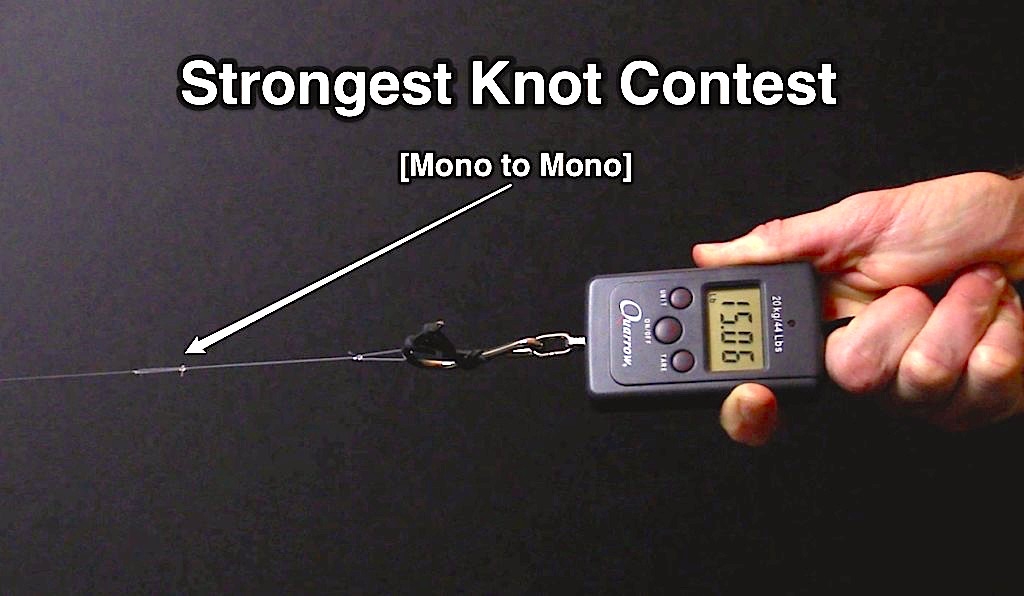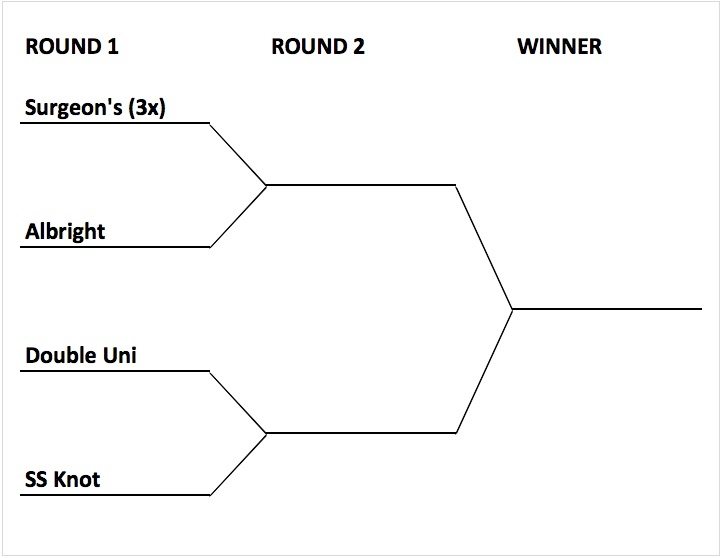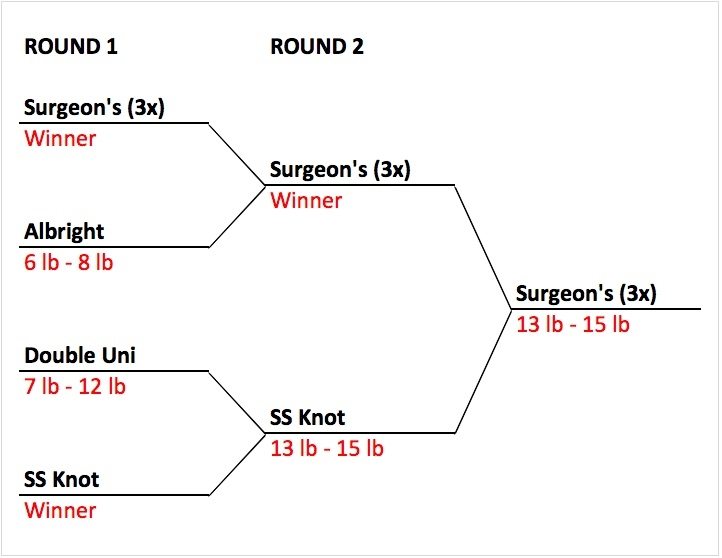The Strongest Line-to-Line Fishing Knot (Mono-to-Mono Knot Contest)
- By: Luke Simonds
- on
- Found In: Fishing Knots, Fishing Tips, Knot Contest, Mono to Leader

Fact: All fishing knots are NOT created equal… our latest line to line knot contest confirmed that fact yet again…
Before hosting these knot strength contests, I always believed that as long as my fishing knot didn’t unravel or break under pressure, then it was a keeper knot…
However, my theory has completely changed after taking the time to actually test knots against one another, where I was shocked when I watched fishing knots break at significantly different tensions even when using the exact same line.
Sadly, some of these knots that disappointed me in the contest were among my favorites that I had relied on for years… and what I learned from this eye-opening knot contest is that…
The Most Popular Knot Is NOT Always The Best KNOT…

So in this latest Salt Strong fishing knot contest, we focused on connecting two monofilament lines with different diameters together to test their breaking strength. And this knot contest was yet another reminder that the “popularity” of a knot doesn’t necessarily mean that it’s the strongest one.
To finalize the knots that I used for this particular contest, I researched line to line connections and pulled the most popular knots that seemed to have the most positive recommendations in fishing forums and comment strings for connecting mono to mono.
Then, I did some preliminary tests and narrowed the field down to just 4 knots… and I also made room for my all-time favorite knot that I’ve used and loved for many years before I switched over to braid for my main line… details and results below:

Disclaimer: I’m a huge advocate of using braid as a main line instead of mono for artificial lure anglers due to it’s more impressive strength and durability… braid allows for longer casts given it’s much smaller diameter while also having knots that are significantly stronger than knots with mono of the same listed line strength (click here to see our braid to leader knot contest).
Monofilament to Leader Knot Contest
This line to line knot contest consists of head to head bouts of two knots that are tied onto the same strand of line, which is then pulled until one of them (the weaker of the two) breaks.
All knots in this contest were used to connect a strand of 10 lb Berkley Trilene (XL Smooth Casting) to a strand of 30 lb Berkley Trilene (Big Game), and the same scale was used to measure the estimated breaking strength of each losing knot…
Each bout consisted of 4 match-ups with only the top 3 breaking strengths used to evaluate the typical breaking range.
Here are the knots used in this contest:
- Surgeon’s Knot
- Albright Knot
- Double Uni Knot
- Salt Strong Knot (I have never seen this knot officially named before, so I call it the Salt Strong knot. However, by no means am I claiming that I invented this knot)
Note: A chart of the match-ups with breaking ranges is shown below.
The Surgeon’s Knot
The surgeon’s knot has really impressed me for both mono to mono and braid to mono connections in these contests. It’s extremely easy and quick to tie, and its breaking strength is very impressive.
Surgeon Knot Pros:
- Quick to tie
- Easy to tie in all conditions
- Strong breaking strength
Surgeon Knot Cons:
- Leader line must be pre-cut and not have anything tied to it
- Tough for long leaders because leader must be passed through a loop 3 times
- It’s bulky with tag ends pointing out (not weedless)
How to Tie Surgeon’s Knot (3-turn method)
Note: See breaking strength test result below
The Albright Knot
The Albright Knot is extremely popular in fishing forums. It’s fairly easy to tie, and it leaves a very small and slim finished product, which likely is the big driver of its popularity since it will allow the knot to easily run through rod guides compared to most others.
Albright Knot Pros
- Slim knot for casting through guides
- Fairly easy to tie
- Good strength
Albright Knot Cons
- It unraveled in 2 tests (not good)
- Not as easy to tie as the other options
- Not as strong as other options
How to Tie The Albright Knot
Note: See breaking strength test result below
Double Uni Knot
The Double Uni Knot is probably the most popular of all line to line knots. It’s easy to tie, strong, and can be used on any type of line (and even direct to hooks/lures).
Double Uni Pros
- Easy to tie
- The “can do it all” knot
- Good for all line types/sizes
Double Uni Cons
- Not the strongest option
- Can be tough to ties on heavy lines
- Large range of breaking strengths
Note: See breaking strength test result below
The Salt Strong Knot
This is a line to line connection that I’ve used for ~20 years but have never known the name of it (if it has one). This knot is essential a unique combination of two different knots (Perfection Loop and Orvis knot) that can be used on lines with extremely different diameters.
Note: I’ve never seen anyone else use this connection style, so of course don’t know if it has a name… it’ll be referred to as the “Salt Strong Knot” for this post.
SS Knot Pros
- Easy to tie
- Very strong
- Great for lines of very different diameters
SS Knot Cons
- Not good for casting through guides
- Takes a bit longer to tie compared to surgeon’s knot
- Requires knowledge of two knots
How to Tie the SS Knot
Note: See breaking strength test result below
Mono to Mono Knot Contest Results
The results of this contest were surprising… I certainly didn’t expect the two least popular knots (Surgeon’s and the no-namer) to be in the finals.
As shown in the contest bracket below, the Albright knot turned out to have the worst breaking strength (6 to 8 lbs) with the Double Uni knot placing in 3rd with a breaking range of 7 to 12 lbs… which was the most inconsistent of them all.
And the two lesser used knots had significantly better results… both had the exact same range of 13 to 15 lbs with the slight edge going to the 3 turn Surgeon’s knot since it won 2 out of 3 in the final round.
Conclusion
Given how close the Surgeon’s and the Salt Strong knot ended up being in the final face-off, they both can certainly be great options to use.
When in a rush, the Surgeon’s knot is the winner since it’s extremely fast to tie and very strong. However, the Salt Strong Knot is a bit slimmer, about the same strength, and it’s much more versatile since it can be used for leaders of all lengths and it can be tied to a leader that already has a lure/hook attached to it.
If you are not yet using either of these knots, then I highly recommend giving them both a try and choose the one that fits your needs best.
Note: This contest is by no means finalized. We’ll update it as more knot ideas come in, so be sure to let us know if your favorite mono to mono knot isn’t included and we’ll test it out… just leave a comment below or send us an email.
And if you have any ideas, suggestions, or questions on this knot contest, please leave a comment.
Go To Our Knot Testing Homepage [Full Knot Rankings]
Related categories:
STOP WASTING TIME ON THE WATER!
Do what the “SMART ANGLERS” are doing and join the Insider Club.
Here’s what you’ll receive today when you join:
- Weekly fishing reports and TRENDS revealing exactly where you should fish every trip
- Weekly “spot dissection” videos that walk you through all the best spots in your area
- Exclusive fishing tips from the PROS you can’t find anywhere else
- Everything you need to start catching fish more consistently (regardless if you fish out of a boat, kayak, or land).











Wondering how the SS knot would do if the Orvis knot was replaced with a Uni Knot
about splicing, it’s an art of it’s own, you can end up with splices that only hold about 60% but if you know the sience and how to get the right taper 95%+ are fully and consistantly possible!
btw, biminis can be as low as 70% and that’s not uncommon…
Well, the by far strongest knot for mono is the Aussie Plait, I customized it and created a terminal and a line-line version, it tests to 95-100% if done right, the art is gettin’ it tight enough, but not so tight that the strands cut each other… for mono-braid only PR and splives take the win, FG is not nearly as strong and durable, everythin’ else, exept for bimini twist will fail at about 30% line strength when put under pressure for several hours, still ok for normal uses but you never know if you will have to fight a fish you didn’t expect and push everythin’ to the absolute limits. Oh and for the Uni-Knot: the wire diameter of the terminal tackle you tie to should be 2.5-5 times the lines diameter and you should have at least five wraps, layed perfectly even with the technique used for the rizutto-finnish, so you reach 80-100% depending on the line, I’ve even done it with 600lb mono, no prob…there’s a lot to learn about knots and line connections but just a handful outperform everythin else!
Tight lines y’all
PS: the uni will still not last like the knots listed above.
PSS:btw, biminis can be as low as 70% and that’s not uncommon…
PSSS:about splicing, it’s an art of it’s own, you can end up with splices that only hold about 60% but if you know the sience and how to get the right taper 95%+ are fully and consistantly possible!
Thanks making time to post the helpful information Marlon!
sure! did tons of researche and testing myself. one thing that just jumped into my mind is that the knotless connectors aren’t the strongest way for braid either, splicing is great but especially for thinner braid the PR knot to a mono leader is the way to go, have done tests with it and the braid always broke in th eknotless connector, not in my PR! of course every line is different and not everyone does his PR right, also be super careful when melting ends, especially on braid but in general a good PR is definetly stronger, I even use it on 10 and 20 pond braid which is the lightest I fish, there I just take a two ounce sinker instead of a bobbin, do a clinck knot on slip so I have some extra line and tie my knot that will last til the line is worn down and ready for the trash.
i really like useing this KNOTwhen i am fishing so i don’t have to keep tieing after ever cast and then it just save me time.
Very interesting. As always, you guys do a great job.
Another consideration is the consistency of the quality of the knot tied. The knot is only as strong as the quality of the tie, and the easier the tie the greater the chance of getting a “good” knot. This is especially true when on the water rushing to get back fishing. I think the surgeon’s knot would show the highest degree of consistently in knot strength. While knots become 2nd nature to those us us that spend a couple hundred days a year on the water, the average weekend angler does not have this experience to rely on. When using this knot, I prefer a triple over a double not just because it is a bit stronger but because with a double, the lines will offset and the 3rd loop will make them come off more in-line so they will offer smoother casts and pick up less gunk. I’ve also been known to tie a surgeon’s knot with a fly (or lure) attached by simply making a large loop. And to reinforce and emphasize what you mentioned, it is the absolutely the best knot to use when the lines are of different diameter. When you factor in the speed of the tie, I believe this makes the surgeon’s loop the best knot for most piscators is most situations.
Unrelated, I would be curious to see a test showing the effects of wetting the knot with spit before drawing it down. Keep up the good work guys and as always, tight lines. Mark
Did you notice which side of the knot was breaking? In my testing, the Surgeon’s knot is weaker on the tag end (leader) side. That makes sense when you look at how the line is wrapped. But it also means that a heavier leader tied to the main line gives almost the full strength of the main line. It also seems this effect is lessened with heavier line.
E.g.
10# mono main to 10# mono leader broke around 7 pounds on the leader side
10# mono main to 20# mono leader broke around 9 pounds on the main side
20# mono main to 10# mono leader broke around 7 pounds on the leader side
20# mono main to 20# mono leader broke around 18 pounds (I didn’t note which side)
The break happens on the side of the mainline for all of my tests due to the fact that I always use a lighter mainline compared to my leader line.
I wonder why your 20lb mainline to 10lb leader broke so much lower than your 10lb mainline to 20lb leader… I would have assumed they’d be the same since the surgeons knot treats both lines the same way. How many times did you repeat those break tests?
the albright broke at 6-8lbs? unless i understood that wrong, I’ve caught big yellowtail with that and had no problems with the knot
Yes, the albright broke at the lowest rate for this mono to mono test… it does great with braid to mono, but it does not seem to be nearly as effective with connecting a mono to another mono.
Is it possibly because you put a point on the knot when you tied it? I heard that any sort of crimping is really bad for mono’s strength and to be avoided.
Yes, a crimp in the line will most often create a weak point. The Albright knot is designed to put a crimp in the thicker line, so the one I made was just to help control where it happens as the knot is cinched down.
Note: Pretty much all knots leave some sort of crimp (hard turn) in the line… this is why a tension break pretty much always happens inside a knot.
Do you know any knots that can be used for mono that will serve like a taut line hitch, not for fishing, but for ha gung decorations ?
The uni knot seems like it is very similar to the taut line hitch.
It is similar in form but different in function. I want a knot to stretch mono tight between two fixed points, or to hang something at a precise length.
What knot would u suggest to connect 12lb mono to 20lb mono for a mainline ?
Thank you
A double uni knot is a great choice for those lines.